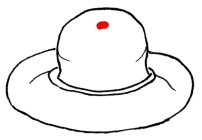RAS taxon details
Diadematacea
152528 (urn:lsid:marinespecies.org:taxname:152528)
Duncan, 1889 (emend. Mongiardino Koch et al., 2022)
accepted
Superorder
marine, brackish, fresh, terrestrial
recent + fossil
Not documented
Kroh, A.; Mooi, R. (2025). World Echinoidea Database. Diadematacea. Accessed through: RAS (Eds.) (2025) Register of Antarctic Species at: https://ras.biodiversity.aq/aphia.php/www.pfeil-verlag.de/04biol/rest/aphia.php?p=taxdetails&id=152528 on 2025-09-12
RAS (Eds.) (2025). Register of Antarctic Species. Diadematacea. Accessed at: https://ras.biodiversity.aq/aphia.php/www.pfeil-verlag.de/04biol/www.pfeil-verlag.de/04biol/aphia.php?p=taxdetails&id=152528 on 2025-09-12
Date
action
by
taxonomy source
Mongiardino Koch, N.; Coppard, S. E.; Lessios, H. A.; Briggs, D. E. G.; Mooi, R.; Rouse, G. W. (2018). A phylogenomic resolution of the sea urchin tree of life. <em>BMC Evolutionary Biology.</em> 18(1)., available online at https://doi.org/10.1186/s12862-018-1300-4
page(s): 11 [details]
context source (PeRMS) Solís-Marín, F. A.; Alvarado, J. J.; Abreu-Pérez, M.; Aguilera, O.; Alió, J.; Bacallado-Aránega, J. J.; Barraza, E.; Benavides-Serrato, M.; Benítez-Villalobos, F.; Betancourt-Fernández, L.; Borges, M.; Brandt, M.; Brogger, M. I.; Borrero-Pérez, G. H.; Buitrón-Sánchez, E.; Campos, L. S.; Cantera, J.; Clemente, S.; Cohen-Renjifo, M.; Coppard, S.; Costa-Lotufo, L. V.; del Valle-García, R.; Díaz, Y.; Díaz de Vivar, M. E.; Díaz-Martínez, J. P.; Durán-González, A.; Epherra, L.; Escolar, M.; Francisco, V.; Freire, C. A.; García-Arrarás, E.; Gil, D. G.; Guarderas, P.; Hadel, V. F.; Hearn, A.; Hernández, J. C.; Hernández-Delgado, E. A.; Herrera-Moreno, A.; Herrero-Pérezrul, M. D.; Hooker, Y.; Honey-Escandón, M. B. I.; Lodeiros, C.; Luzuriaga, M.; Manso, C. L. C.; Martín, A.; Martinez, M. I.; Martínez, S.; Moro-Abad; Mutschke, E.; Navarro, J. C.; Neira, R.; Noriega, N.; Palleiro-Nayar, J. S.; Pérez, A. F.; Pérez-Ruzafa, A.; Prieto-Rios, E.; Reyes, J.; Rodríguez, R.; Rubilar, T.; Sancho-Mejía, T.; Sangil, C.; Silva, J. R. M. C.; Sonnenholzner, J. I.; Ventura, C. R.; Tablado, A.; Tavares, Y.; Tiago, C. G.; Tuya, F.;Williams, S. M. (2013). Appendix. <em>In: J. J. Alvarado & F. A. Solís-Marín (eds), Echinoderm Research and Diversity in Latin America.</em> pp. 471-510. Springer; Berlin & Heidelberg. page(s): 543-654. [details]
basis of record Kroh, A. & Smith, A.B. (2010): The phylogeny and classification of post-Palaeozoic echinoids. Journal of Systematic Palaeontology, 8/2: 147-212., available online at http://www.informaworld.com/openurl?genre=article&issn=1477-2019&volume=8&issue=2&spage=147 [details]
status source Kroh, A. (2020). Phylogeny and classification of echinoids. <em>Developments in Aquaculture and Fisheries Science.</em> 1-17., available online at https://doi.org/10.1016/b978-0-12-819570-3.00001-9
page(s): 4-5 [details] Available for editors
page(s): 11 [details]
context source (PeRMS) Solís-Marín, F. A.; Alvarado, J. J.; Abreu-Pérez, M.; Aguilera, O.; Alió, J.; Bacallado-Aránega, J. J.; Barraza, E.; Benavides-Serrato, M.; Benítez-Villalobos, F.; Betancourt-Fernández, L.; Borges, M.; Brandt, M.; Brogger, M. I.; Borrero-Pérez, G. H.; Buitrón-Sánchez, E.; Campos, L. S.; Cantera, J.; Clemente, S.; Cohen-Renjifo, M.; Coppard, S.; Costa-Lotufo, L. V.; del Valle-García, R.; Díaz, Y.; Díaz de Vivar, M. E.; Díaz-Martínez, J. P.; Durán-González, A.; Epherra, L.; Escolar, M.; Francisco, V.; Freire, C. A.; García-Arrarás, E.; Gil, D. G.; Guarderas, P.; Hadel, V. F.; Hearn, A.; Hernández, J. C.; Hernández-Delgado, E. A.; Herrera-Moreno, A.; Herrero-Pérezrul, M. D.; Hooker, Y.; Honey-Escandón, M. B. I.; Lodeiros, C.; Luzuriaga, M.; Manso, C. L. C.; Martín, A.; Martinez, M. I.; Martínez, S.; Moro-Abad; Mutschke, E.; Navarro, J. C.; Neira, R.; Noriega, N.; Palleiro-Nayar, J. S.; Pérez, A. F.; Pérez-Ruzafa, A.; Prieto-Rios, E.; Reyes, J.; Rodríguez, R.; Rubilar, T.; Sancho-Mejía, T.; Sangil, C.; Silva, J. R. M. C.; Sonnenholzner, J. I.; Ventura, C. R.; Tablado, A.; Tavares, Y.; Tiago, C. G.; Tuya, F.;Williams, S. M. (2013). Appendix. <em>In: J. J. Alvarado & F. A. Solís-Marín (eds), Echinoderm Research and Diversity in Latin America.</em> pp. 471-510. Springer; Berlin & Heidelberg. page(s): 543-654. [details]
basis of record Kroh, A. & Smith, A.B. (2010): The phylogeny and classification of post-Palaeozoic echinoids. Journal of Systematic Palaeontology, 8/2: 147-212., available online at http://www.informaworld.com/openurl?genre=article&issn=1477-2019&volume=8&issue=2&spage=147 [details]
status source Kroh, A. (2020). Phylogeny and classification of echinoids. <em>Developments in Aquaculture and Fisheries Science.</em> 1-17., available online at https://doi.org/10.1016/b978-0-12-819570-3.00001-9
page(s): 4-5 [details] Available for editors
